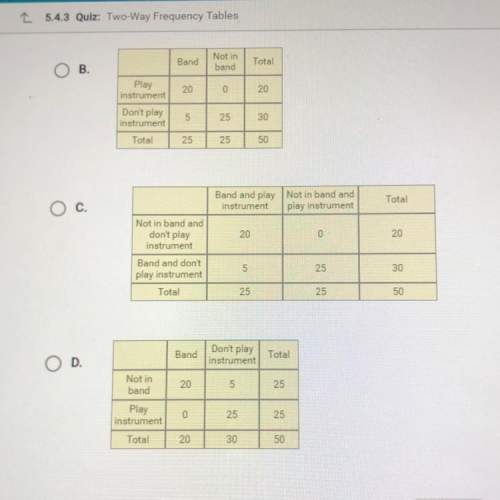
Mathematics, 01.08.2020 06:01 glitch14
4.10.4Test (TST):Three-Dimensional SolidsTest
Geometry Sem 2
Points Possible:50
Name:Annie PaliderDate:
Answer the following questions using what you've learned from this unit. Write your responses in the space provided.
1. You are making a fruit salad. You cut a banana in half and think of it as a cylinder with the cut you made as its base. Then, you consider the different shapes you can get depending on the way you cut the banana.
Part 1: Describe the shape of the cross sections if you slice the banana parallel to its base. Draw a picture of the shape. (1 point)
Part II: Describe the shape of your cross sections if you slice the banana at a 45 angle to its base. Draw a picture of the shape. (1 point)
Part III: Describe the shape of your cross sections if you slice the banana in half, with a cut perpendicular to its base. Draw a picture of the shape. (Hint: Remember to think of the banana as a cylinder.) (1 point)
2. The surface area of a three-dimensional figure is the sum of the area measures for each of the figure's faces. Find the surface area of the cube shown below.
Part 1: How many faces does the cube shown above have? (1 point)
Part II: Find the area of one face of the cube shown above. Show your work. (2 points)
Part III: Find the surface area of the cube shown above. Show your work. (2 points)
3. Find the surface area of the cylinder shown below.
The surface area of a cylinder can be found by:
Part I: Find the lateral area of the cylinder by using the portion of the formula above. Show your work and leave your answer in terms of pi. (2 points)
Part II: Find the area of the bases of the cylinder by using the portion of the formula above. Show your work and leave your answer in terms of pi. (2 points)
Part III: Use your answers from Parts I and II to find the surface area of the cylinder above. Show your work and round your answer to the nearest tenth. (1 point)
4. Suppose you have a funnel in the shape of a right cone as shown below. Find the lateral area.
Part I: Find the radius of the cone. (2 points)
Part II: Use your answer from Part I with the Pythagorean Theorem to find the slant height of the cone. Show your work. (3 points)
Part III: Use the formula below to find the lateral area of the cone pictured above. Show your work and round your answer to the nearest hundredth. (5 points)
Lateral area of a cone:
5.
Part I: Find the volume of the cylinder shown using the formula in the box below. Round your answer to the nearest tenth. Show your work. (5 points)
The volume of a cylinder:
6.
Part I: Suppose a prism has a square base with each side of length 3.75 cm and a height of 5.65 cm. Use the formula below to find the volume. Show your work and round your answer to the nearest hundredth. (5 points)
The volume of a prism:
7. Suppose a sphere has a volume of 3,000 cm3. Find the surface area.
The volume of a sphere:
Part I: Find the radius of the sphere by setting the volume equal to the formula above. Show your work and round the radius to the nearest hundredth. (5 points)
Part II: Use the radius you found in Part I with the surface area formula below to the find the surface area of the sphere. Show your work and round your answer to the nearest tenth. (5 points)
The surface area of a sphere:
8. The volumes of two similar solids are 512 cm3 and 2,197 cm3. If the smaller solid has a surface area of 960 cm2, find the surface area of the larger solid.
Part I: Find the similarity ratio by taking the cube root of each volume. Show your work. (2 points)
Part II: Use your answer from Part I to find the ratio of the surface areas. Show your work. (2 points)
Part III: Set up a proportion and solve to find the surface area of the larger solid. (3 points)

Answers: 2
Another question on Mathematics

Mathematics, 21.06.2019 13:30
Ametalworker has a metal alloy that is 30? % copper and another alloy that is 55? % copper. how many kilograms of each alloy should the metalworker combine to create 90 kg of a 50? % copper? alloy?
Answers: 3

Mathematics, 21.06.2019 15:00
Which statement is always true? a. square bcdf is a rectangle. b. rectangle gjkm is a square. c. quadrilateral stpr is a trapezoid. d. parallelogram abcd is a rhombus.
Answers: 2

Mathematics, 21.06.2019 17:00
When you are making a circle graph by hand, how do you convert a number for a part into its corresponding angle measure in the circle graph? when you are making a circle graph by hand, what should you do if one of your angle measures is greater than 180°?
Answers: 2

Mathematics, 21.06.2019 18:00
Compare the cost of the bike trips from the two companies shown.for both the cost in a linear function of the number of days which statements is true
Answers: 2
You know the right answer?
4.10.4Test (TST):Three-Dimensional SolidsTest
Geometry Sem 2
Points Possible:50
Name:An...
Points Possible:50
Name:An...
Questions

Mathematics, 22.03.2021 16:20

Computers and Technology, 22.03.2021 16:20

History, 22.03.2021 16:20

Mathematics, 22.03.2021 16:20

Chemistry, 22.03.2021 16:20

Biology, 22.03.2021 16:20

Law, 22.03.2021 16:20





Mathematics, 22.03.2021 16:20

Biology, 22.03.2021 16:20

Medicine, 22.03.2021 16:20

Mathematics, 22.03.2021 16:20


Biology, 22.03.2021 16:20

History, 22.03.2021 16:20


Mathematics, 22.03.2021 16:20




